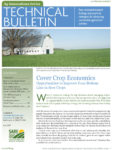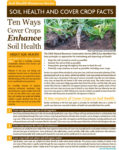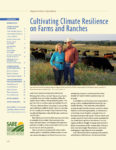Showing 11-20 of 76 results

Cover Crop Economics
Cover crops can build soil health, control weeds, conserve moisture, provide grazing opportunities and more. But when do they start to pay for themselves? This analysis looks at the economics behind different management scenarios to determine if cover crops are likely to improve profitability in one, three or five years of use in corn and soybean rotations.

What is Soil Health?
Soil health plays an essential role in raising healthy, productive crops and livestock. With this interactive infographic, learn how practices such as cover crops, no-till, crop rotation and the integration of livestock work in concert to improve soil health.

Improving Soil Health Through Cover Crops
Farmers around the country are discovering the power of cover crops to curb erosion and improve soil health. This video is from Pennsylvania, where a Penn State researcher and a grain farmer are partnering to spread the word.

10 Ways Cover Crops Enhance Soil Health
Soil health is a hot topic these days, one that is justifiably receiving considerable attention from farmers and their farm advisors. This short fact sheet highlights some of the key ways that cover crops improve soil health by influencing the biological and physical characteristics of the soil.

Cultivating Climate Resilience on Farms and Ranches
This bulletin outlines the new challenges that changing weather patterns pose in agriculture throughout the United States, and what you can do to make your farm more resilient.

Advanced Cover Cropping Insights from Farmer Experts
Great Plains Perspective Central Corn Belt Perspective Eastern Perspective

Recordings of General Sessions
Opening remarks by Jane Hardisty (USDA-NRCS Indiana) with video message Bill Northey (Iowa Secretary of Agriculture) Keynote: Growing a Revolution - Bringing Our Soil Back to Life, by David Montgomery (University of Washington) Farmer panel: Experiences with Cover Crops and Soil Health, with Dan DeSutter (Ind.), Trey Hill (Md.) and Jimmy Emmons (Okla.) Top 10 Ways Cover Crops Build Soil Health, by Rob Myers (North Central SARE) Plenary session: Carbonomics, by Keith Berns (Neb. farmer and Green Cover Seed)

2017 National Conference on Cover Crops and Soil Health
Session recordings are available from the second National Conference on Cover Crops and Soil Health. The event served as an opportunity to learn recent developments in how cover crops are being used by innovative farmers across the country and gain important insights on improving soil health from producers, conservation leaders and scientists. It was held December 7-8, 2017 in Indianapolis.

Basics of Cover Cropping
Introduction to Cover Crops Selecting and Establishing Cover Crops Terminating Cover Crops Plus Strategies for Planting a Cash Crop Following Cover Crops

Digging into Soil Health
Soil Health Principles Soil Health Testing and Practices Soil Biology and Organic Matter